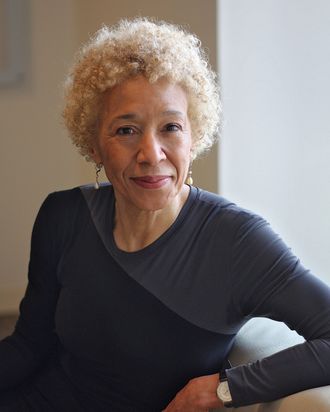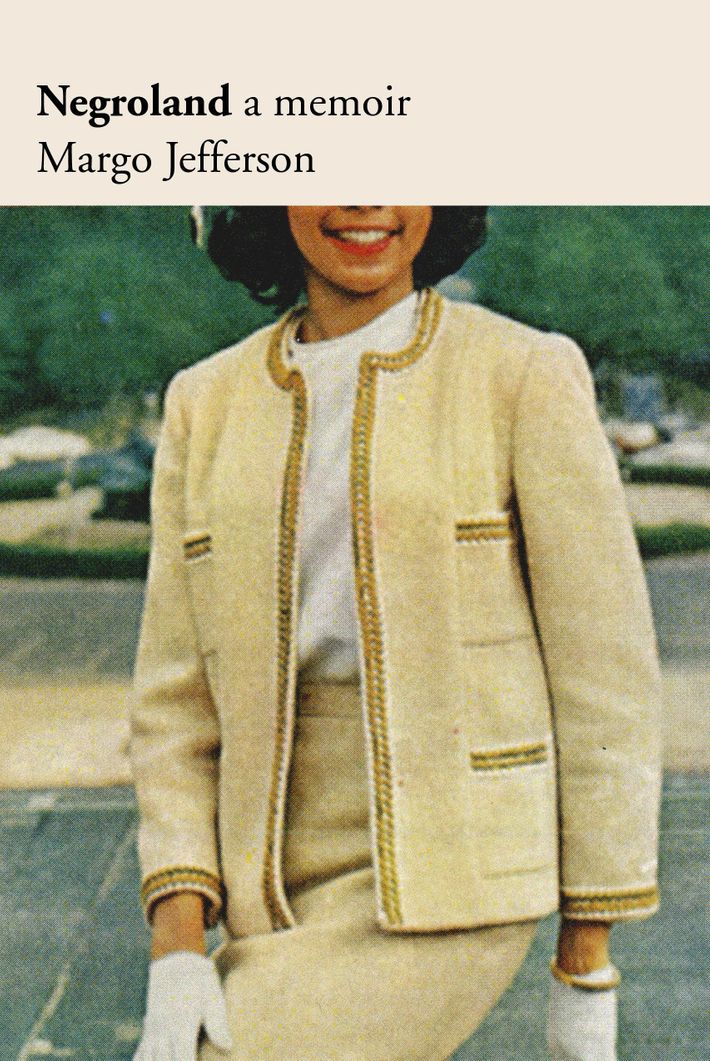
In her latest book, the Pulitzer Prize–winning critic Margo Jefferson offers a new definition of “Negroland.” “Negroland is my name for a small region of Negro America where residents were sheltered by a certain amount of privilege and plenty,” she writes in the introduction to her new memoir. Chronicling her affluent upbringing in Chicago, which hits shelves September 8, Negroland is a sharp reflection on the intersection of race and class in mid-century America.
A candid observer, Jefferson articulates the complicated and calculated performance of upper-class black life. “Nothing highlighted our privileged more than the menace to it,” she writes. “Inside the race we were the self-designated aristocrats, educated, affluent accomplished; to Caucasians we were oddities, underdogs and interlopers … we knew what was expected of us. Negro privilege had to be circumspect: impeccable but not arrogant; confident yet obliging; dignified, not intrusive.” In the excerpt below, Jefferson considers another paradox of her privilege: her experience with depression and thoughts of suicide, and the pressure she felt as a black woman to hide it.

In the late 1970s, I began to actively cultivate a desire to kill myself. I was, at the time, a successful professional in my chosen field of journalism. I was also a passionate feminist who refused to admit any contradiction between, on the one hand, her commitment to fighting the oppression of women and, on the other, her belief that feminism would let her draft a death commensurate with social achievement and political awareness.
A little background is needed here. The women’s movement was controversial in the black community at this time. Many men and all too many women denounced feminism as a white woman’s thing, an indulgence, even an assertion of privilege, since she was competing (and stridently) for the limited share of benefits white men had just begun to grant nonwhites.
Black feminists responded that, thanks to sexism, women of color regularly got double blasts of discrimination and oppression. And, anyway, we had our own feminist history. Relations between white and black women had been wary, inequitable, or bluntly exploitative. Alliances between them had been scant and fraught.
Nevertheless, social and cultural progress through the decades had made interracial cooperation and friendship available to my generation. I’d had white friends since kindergarten. And I was willing to acknowledge this irony; the rituals of bourgeois femininity had given the girls of Negroland certain protections the boys lacked.
That vision of feral, fascinating black manhood possessed Americans of every race and class. If you were a successful upper-middle-class Negro girl in the 1950s and ‘60s you were, in practice and imagination, a white Protestant upper middle-class girl. Young, good-looking white women were the most desirable creatures in the world. It was hard not to want to imitate them; it was highly toxic, too, as we would learn.
Still, these rituals allowed girls the latitude to go about their studies while being pert and popular, to stay well-mannered and socially adaptable, even as they joined the protests of the sixties and seventies.
So, when the black movement and the women’s movement offered new social and cultural opportunities, we were ready to accept them.
But one white female privilege had always been withheld from the girls of Negroland. Aside from the privilege of actually being white, they had been denied the privilege of freely yielding to depression, of flaunting neurosis as a mark of social and psychic complexity. A privilege that was glorified in the literature of white female suffering and resistance. A privilege Good Negro Girls had been denied by our history of duty, obligation, and discipline. Because our people had endured horrors and prevailed, even triumphed, their descendants should be too strong and too proud for such behavior. We were to be ladies, responsible Negro women, and indomitable Black Women. We were not to be depressed or unduly high-strung; we were not to have nervous collapses. We had a legacy. We were too strong for that.
I craved the right to turn my face to the wall, to create a death commensurate with bourgeois achievement, political awareness, and aesthetically compelling feminine despair. My first forays in this direction were petty. I conducted my own small battle of the books, purging my library of stalwart, valorous titles by black women and replacing them, whenever possible, with morbid, truculent ones by my sisters. Out with This Child’s Gonna Live, up with There’s Nothing I Own That I Want. Good-bye, My Lord, What a Morning, by Marian Anderson; hello, Everything and Nothing by Dorothy Dandridge. As for Mari Evans’s iconic sixties poem:
I am a black woman
…
strong
beyond all definition still
defying place
and time
and circumstance
assailed
impervious
indestructible
Look
on me and be
renewed
I tore it out of my black poets’ anthology and set fire to it in the bathroom sink.
I found literary idols in Adrienne Kennedy, Nella Larsen, and Ntozake Shange, writers who’d dared to locate a sanctioned, forbidden space between white vulnerability and black invincibility.
A Negro girl could never be purely innocent. The vengeful Race Fairy always lurked nearby; your parents’ best hope was that the fairy would show up at someone else’s feast and punish their child. Parents had to protect themselves, too, and protect you from knowing how much danger you all were in.
And so arose one variation on the classic Freudian primal scene in which the child sees or imagines her parents having sex and finds it stirringly violent. Here the child sees and imagines her parents having fraught encounters with white people who invade their conversation and shadow their lives beyond the boundaries of home or neighborhood.
Work hard, child. Internalize the figures of your mother, your father, your parents (one omnipotent double-gendered personage). Internalize The Race. Internalize both races. Then internalize the contradictions. Teach your psyche to adapt its solo life to a group obbligato. Or else let it abandon any impulse toward independence and hurtle toward a feverishly perfect presentation of your people.
***
The first unapologetic black female suicide took place in a small Off Broadway theater in 1964, in a short gothic play by a fiercely imaginative Negro woman playwright. I wasn’t there, but I understood that Adrienne Kennedy’s Funnyhouse of a Negro was as much a demand for freedom as the Civil Rights Act passed the same year.
Kennedy’s heroine, Negro-Sarah, was a young middle-class woman, “good-looking in a boring way; no glaring Negroid features, medium nose, medium mouth, and pale yellow skin. My one defect is that I have a head of frizzy hair, unmistakably Negro-hair …” She lives alone in an Upper West Side brownstone, longs to be bohemian and distinctive, fears she is merely drab and decorous. She mistrusts her white poet boyfriend: “He is very interested in Negros.” She mistrusts he own passion for white culture. Its great works have no place for her; its great figures would deem her an insignificant cultural arriviste. One woman, one room, one anguished, polyphonic consciousness. Queen Victoria and the Duchess of Hapsburg prowl her psyche, lamenting the awful curse of blackness. Patrice Lumumba and a shadowy black father are there, too; they struggle and fail to lift that curse. At the play’s end, the light goes black, then blazes white. “The poor bitch has hung herself,” says the landlady. “She was a funny little liar,” adds the boyfriend.
Negro-Sarah embodies our Negroland legacy of proscription and privilege, grief and achievement, a mingled love and shame for our people, a mingled love and terror of white culture. And then (as if the result of these others), a despair and a furious will to extinguish the self. My people’s enemies have done this to me. But so have my own loved ones. My enemies took too much. My loved ones asked too much.
Let me say with care that the blame is not symmetrical: My enemies forced my loved ones to ask too much of me.
***
Nella Larsen’s 1920s novels were republished in the late 1960s and early ‘70s, part of an exuberant rush of books by women, by gays, by nonwhites of every hue, that the culture had contentedly left out of print for years. Some of these books appeared in pleasing well-wrought editions. Larsen’s were among those given the cheapest paper and crudest design publishers could get away with. Her own heroines would have disdained to buy them.
For they are touchy and proud, these Jazz Age heroines. They read widely, wear soignée frocks, give smart parties, and make clever remarks. They have keen minds, keen features, and fair skin, and can be suitably ironic about “what called itself Negro society.” They cultivate the advantages of being New Negroes and New Women; sometimes they even indulge in being New Negroes who can pass for white. They pursue La Vie Bourgeoise with too much anxiety or too much ambivalence. Their sexual allure trips them up; their sexual reserve holds them back. They are timid where they should be bold, reckless when diplomacy is needed. Secretly, they feel contempt for their own failure to imagine anything more for themselves.
Each one finds death of some kind: a lethal marriage, a fatal accident. But their longing for death, the drive toward it, is never quite acknowledged. Her women stumble into suicide by misadventure or miscalculation. They avoid premeditation, just as they avoid stringent self-reflection.
***
So, when Ntozake Shange stood on the stage of the Public Theater in 1975 and spoke the words “And this is for colored girls who have considered suicide,” my heart took flight. We were the same age. We were both doctors’ daughters who’d attacked our girlhood gentility with the blunt weapons of Black Power and radical feminism. Now we could consider — toy with, ponder, contemplate — suicide.
I tried to quash my envy by seeing the play two, three, and four times, taking friends and paying for their tickets. I told myself, Ntozake is laying the groundwork for all black feminists. She’s taken her stand as an artist, while you hide behind being a journalist. You must rid yourself of jealousy. You hate the second-raters who quibble with the brave ones. I’d always derided Anne Sexton’s suicide competitions with Sylvia Plath. “Thief,” Sexton wrote, “how did you crawl into, / crawl down alone into the death I wanted so badly and for so long?” Maybe because Plath had more nerve and wrote better poetry was my answer.
I channeled my envy into aesthetic dissatisfaction with the words that followed. “For colored girls who have considered suicide when the rainbow is enuf.” It wasn’t enough. It was “For colored girls who are moving to the end of their personal rainbows.” I found the rainbow overused and trite, and even if it was an honored symbol in every culture, a sanctioned trope of lyric poetry. When I’d finished this spiteful formalist critique, I was left alone with my fury. Ntozake said we had found god in ourselves and loved her fiercely. I hadn’t and I didn’t.
I wrote bleak notebook entries and called them death aphorisms.
I loathe my kind, which is humankind. We maim and taint whatever we encounter. We might improve but I don’t think so.
I think more people should kill themselves. What incentives can we offer?
Freud got so much credit for saying “civilizations have death wishes.” I saw individuals have life sentences, and I refuse to be a model prisoner. I shall consider my death an evolutionary advance for the species.
I wrote to the Hemlock Society for instructions. Thirty aspirins minimum, with a liquid that makes you drowsy. Then tie the plastic bag over your head.
I studied suicide notes. It’s a primitive genre — they all follow the same basic pattern. “I can’t go on.” “I’m so sorry to do this to you.” “You’ve been so good to me.” “You’ve been as good as anyone who doesn’t have to go through anything like this can be.”
I kept a folder of my drafts. Sample: “Dear ________: I won’t go on. I’ve known everything was hopeless for a long time. Why keep fighting?” The prose is nothing to write home about — but it’s homeward bound, isn’t it? Add your own personal touch. I always put in something about who my jewelry should go to.
I knew I should have an alternative method and I chose the oven. I liked its literary pedigree — from Hansel and Gretel to Sylvia Plath. When I actually tried putting my head in it, I realized that the oven opens about a foot from the floor, so you have to twist your body around and put your head on the door at a weird, forced angle.
I practiced because I did not want to be found in an ugly sprawl or a fetal position. I started at five minutes and worked my way up to fifteen. One of these days, I pledged, I’ll have the courage to turn the oven on.
I knew that unrequited death is as futile as unrequited love. You must take hold, I told myself. You are suffering the long-term effects of a profound fatigue. This is the result of all the work, the years of work required to be wholly normal and wholly exceptional. You must set an example for other Negroland girls who suffer the same way.
You must give them a death they can live up to.
Excerpted from the book Negroland: A Memoir by Margo Jefferson (Pantheon, September 8, 2015).




